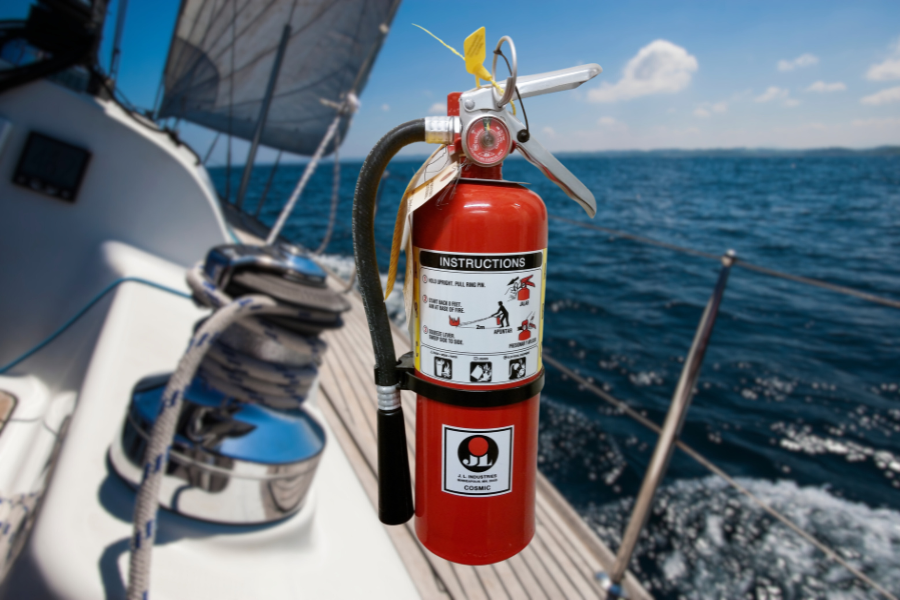Any seasoned boater knows safety should always be a top priority, and a fire extinguisher for boats is of top importance. A couple of years ago we had boater friends anchored off a remote uninhabited island near St Barth’s in the Caribbean. Their boat caught fire, and everything they did to stop it from spreading failed. Luckily, our friends made it off the boat safely but the boat didn’t survive.
Make sure to watch our video and read our article Fire Safety At Sea – 4 Lifesaving Things To Know. Also, if you’re looking to buy a fire extinguisher, check out: Wholesale Marine

Why Fire Extinguishers Are a Must-Have on Board
The last thing you want to worry about while sailing is a fire breaking out. But the reality is it can happen, as I mentioned above. Whether it’s an electrical malfunction, a fuel leak, or even something as simple as a forgotten candle, the potential for disaster is there. A reliable fire extinguisher can mean the difference between a minor scare and a catastrophic loss.
What Types of Fire Extinguishers Should You Have?
Not all fire extinguishers are created equal. On a boat, you’ll typically need one (or more) designed for the specific types of fires you might encounter.
- Type B (Flammable Liquids): This is your go-to for fuel, oil, and grease fires – the most common type on boats.
- Type C (Electrical): Essential for fires in electrical panels, wiring, or appliances.
- Type A (Ordinary Combustibles): Handy for fires involving wood, paper, or fabric.
Automatic Engine Compartment Fire Suppression
For an extra layer of protection, consider an automatic fire extinguisher for your engine compartment. These handy devices are heat-activated, meaning they’ll automatically discharge if the temperature gets too high, often before you even realize there’s a problem. This is especially valuable for engine fires, which can be particularly dangerous and difficult to fight. Watch our Fire Safety at Sea video to check out our engine bay fire extinguisher.
New Regulations (Heads Up!)
If your boat was built in 2018 or later, there are new extinguisher requirements. You’ll need fire extinguishers for boats labeled as 5-B, 10-B, or 20-B. These numbers refer to the size and capacity of the extinguisher. Older boats can use extinguishers labeled B-I or B-II. Just be sure they’re in good condition and haven’t expired. Each extinguisher will have a service date so make sure you know when they need to be serviced.
How Many Fire Extinguisher for Boats Do You Need?
The number you need depends on the size of your boat. Generally, a boat under 26 feet needs one extinguisher, while larger boats need two or three. Check the current U.S. Coast Guard regulations for specifics. Also consider that just because the regulations mandate a certain size, it’s a minimum. On Britican, we opted for larger fire extinguishers to improve our chances of fire-fighting capabilities.
Where Should You Place Fire Extinguishers?
Think of fire extinguishers like life jackets – you need them within easy reach. Place them in easily accessible spots, like the galley, engine compartment, and helm station. Make sure everyone on board knows where they are and how to use them. When we do our boat safety briefing, we show all our guests where our safety gear is located. A couple of our fire extinguishers are not easy to locate if you don’t know where they are.
Maintenance Matters – Fire Extinguisher for Boats
Don’t just stow away your fire extinguisher and forget about it. Check it regularly for signs of damage, corrosion, or leaks. And most importantly, make sure it hasn’t expired! If you have an automatic extinguisher, be sure to follow the manufacturer’s instructions for maintenance and inspection.
Safety First at Sea: The Importance of Fire Safety
Fire safety on board is about more than just having the right equipment. It’s about being prepared, knowing the risks, and having a plan in case of an emergency. Make sure everyone on board understands fire safety procedures and how to use the extinguishers. Remember, a few minutes of preparation can save lives and your vessel.
Sailing Smart – Fire extinguisher for boats!
Being prepared is all part of the adventure of sailing, especially with fire extinguishers for boats. By equipping your boat with the right fire extinguishers and knowing how to use them, you’re not just protecting your vessel, you’re protecting yourself and everyone on board. Safe sailing, everyone! Next, make sure to read/watch Safety on Boats: Do It Yourself Boat Safety Check – 6 Easy Steps